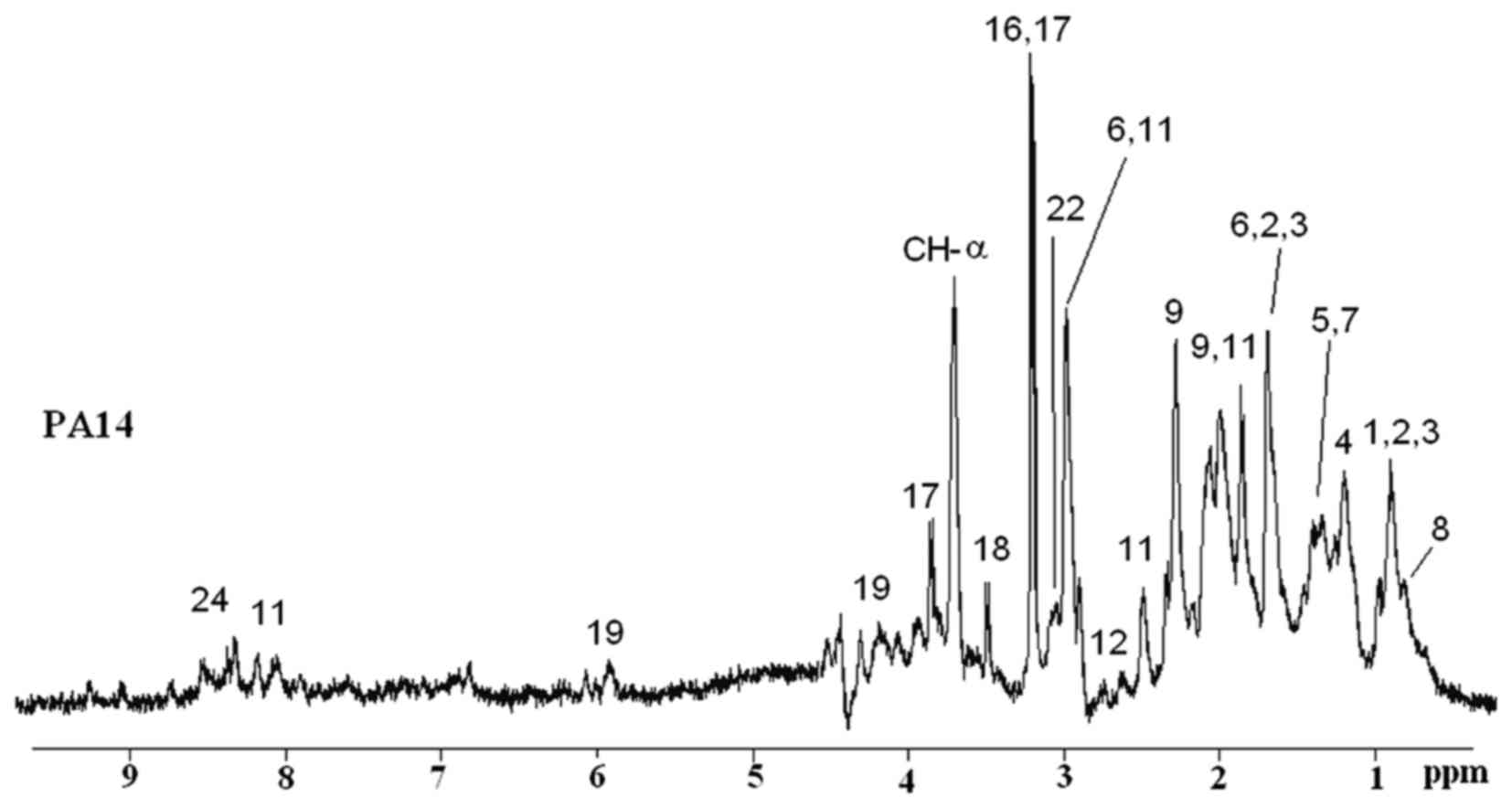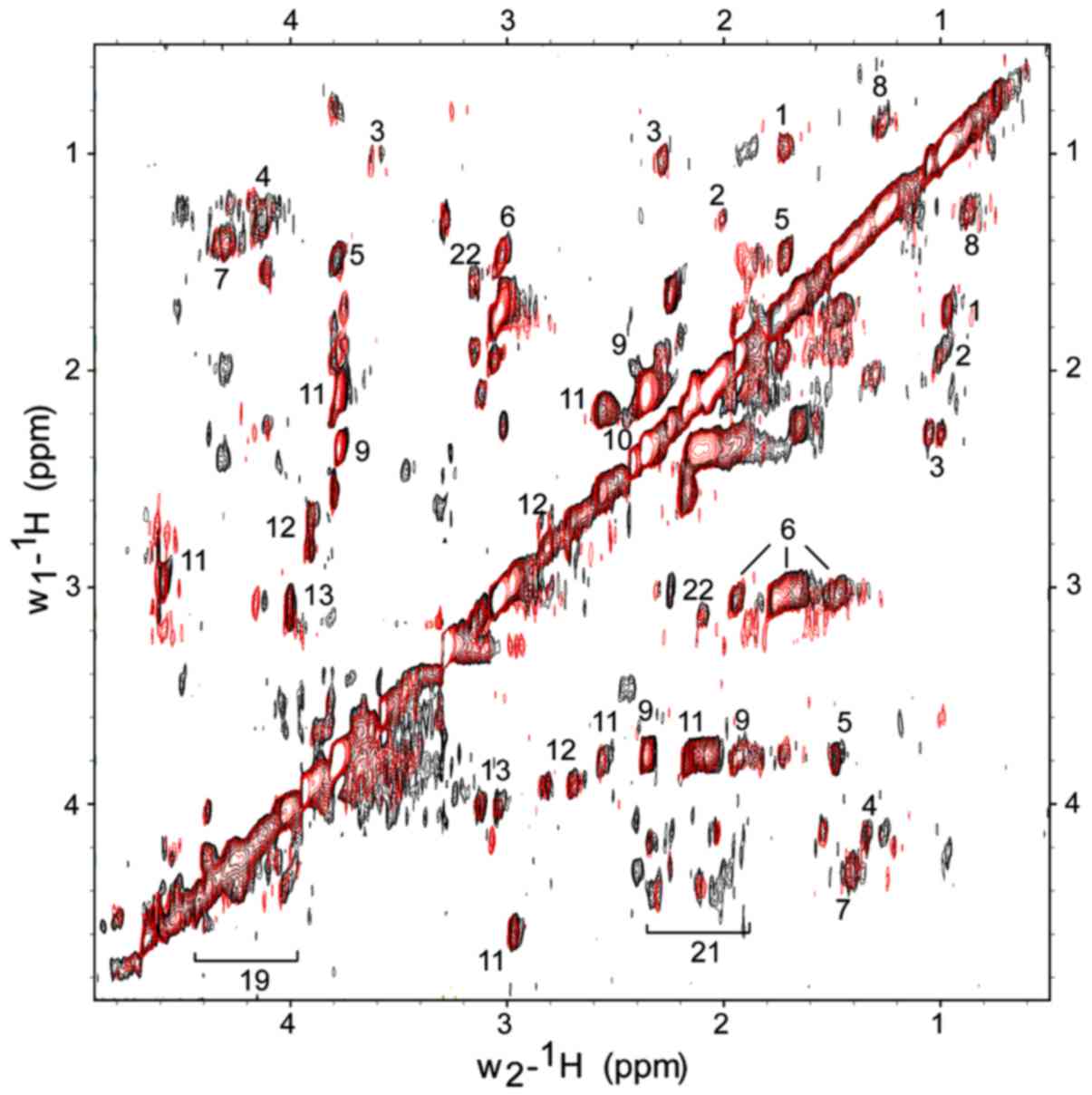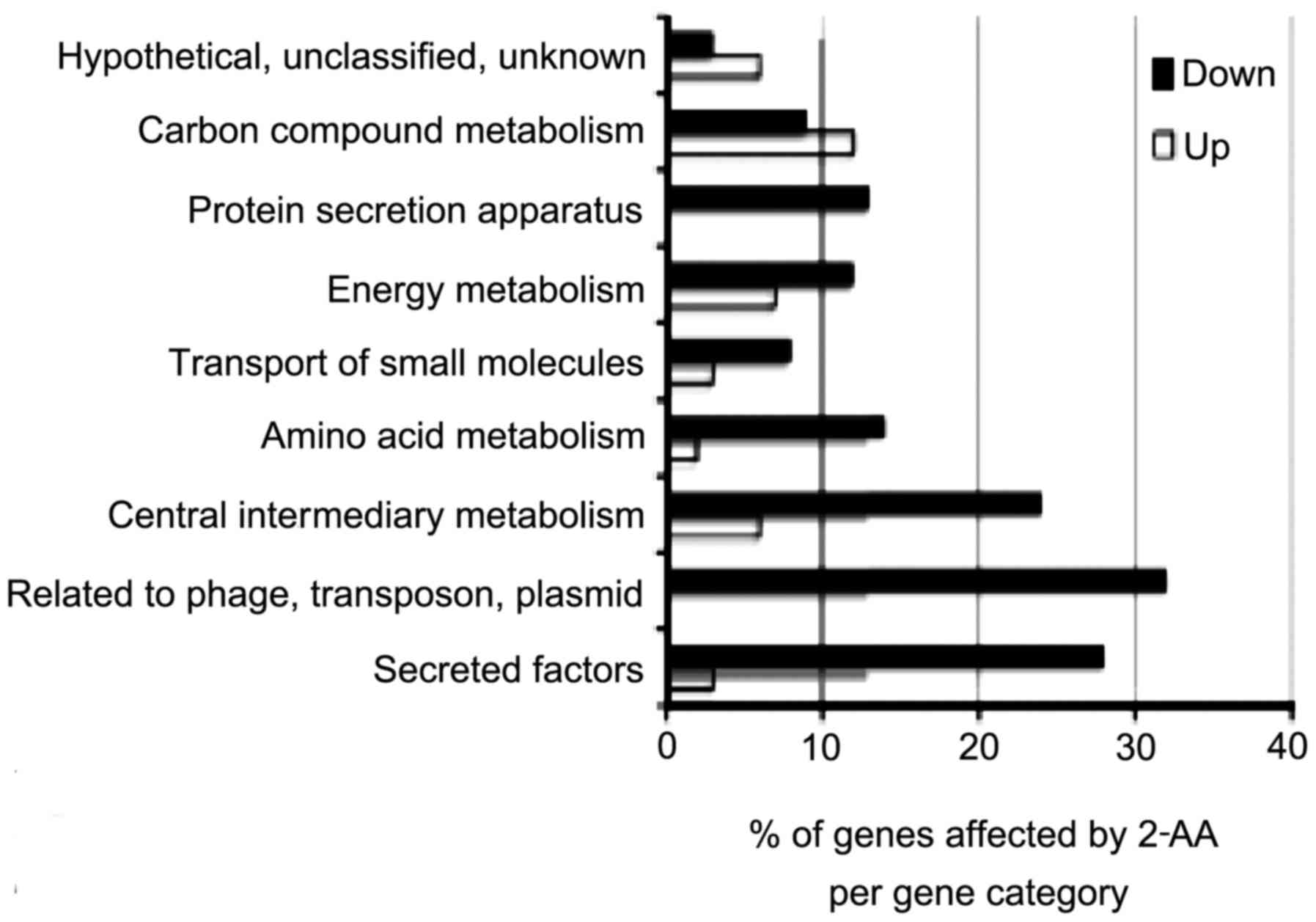|
1
|
Bodey GP: Infectious diseases update:
1982. Summary of a symposium. Rev Infect Dis. 5:232–234. 1983.
View Article : Google Scholar : PubMed/NCBI
|
|
2
|
Koch C and Høiby N: Pathogenesis of cystic
fibrosis. Lancet. 341:1065–1069. 1993. View Article : Google Scholar : PubMed/NCBI
|
|
3
|
Bassler BL and Losick R: Bacterially
speaking. Cell. 125:237–246. 2006. View Article : Google Scholar : PubMed/NCBI
|
|
4
|
Hoffman LR, Déziel E, D'Argenio DA, Lépine
F, Emerson J, McNamara S, Gibson RL, Ramsey BW and Miller SI:
Selection for Staphylococcus aureus small-colony variants due to
growth in the presence of Pseudomonas aeruginosa. Proc Natl Acad
Sci USA. 103:19890–19895. 2006. View Article : Google Scholar : PubMed/NCBI
|
|
5
|
Kesarwani M, Hazan R, He J, Que YA,
Apidianakis Y, Lesic B, Xiao G, Dekimpe V, Milot S, Deziel E, et
al: A quorum sensing regulated small volatile molecule reduces
acute virulence and promotes chronic infection phenotypes. PLoS
Pathog. 7:e10021922011. View Article : Google Scholar : PubMed/NCBI
|
|
6
|
Dmitriev B, Toukach F and Ehlers S:
Towards a comprehensive view of the bacterial cell wall. Trends
Microbiol. 13:569–574. 2005. View Article : Google Scholar : PubMed/NCBI
|
|
7
|
Li W: Multidimensional HRMAS NMR: a
platform for in vivo studies using intact bacterial cells. Analyst.
131:777–781. 2006. View
Article : Google Scholar : PubMed/NCBI
|
|
8
|
Griffin JL: Metabonomics: NMR spectroscopy
and pattern recognition analysis of body fluids and tissues for
characterisation of xenobiotic toxicity and disease diagnosis. Curr
Opin Chem Biol. 7:648–654. 2003. View Article : Google Scholar : PubMed/NCBI
|
|
9
|
Tweeddale H, Notley-McRobb L and Ferenci
T: Effect of slow growth on metabolism of Escherichia coli, as
revealed by global metabolite pool ('metabolome') analysis. J
Bacteriol. 180:5109–5116. 1998.PubMed/NCBI
|
|
10
|
Tweeddale H, Notley-McRobb L and Ferenci
T: Assessing the effect of reactive oxygen species on Escherichia
coli using a metabolome approach. Redox Rep. 4:237–241. 1999.
View Article : Google Scholar
|
|
11
|
Liu X, Ng C and Ferenci T: Global
adaptations resulting from high population densities in Escherichia
coli cultures. J Bacteriol. 182:4158–4164. 2000. View Article : Google Scholar : PubMed/NCBI
|
|
12
|
Himmelreich U, Somorjai RL, Dolenko B, Lee
OC, Daniel HM, Murray R, Mountford CE and Sorrell TC: Rapid
identification of Candida species by using nuclear magnetic
resonance spectroscopy and a statistical classification strategy.
Appl Environ Microbiol. 69:4566–4574. 2003. View Article : Google Scholar : PubMed/NCBI
|
|
13
|
Gudlavalleti SK, Szymanski CM, Jarrell HC
and Stephens DS: In vivo determination of Neisseria meningitidis
serogroup A capsular polysaccharide by whole cell high-resolution
magic angle spinning NMR spectroscopy. Carbohydr Res. 341:557–562.
2006. View Article : Google Scholar : PubMed/NCBI
|
|
14
|
Szymanski CM, Michael FS, Jarrell HC, Li
J, Gilbert M, Larocque S, Vinogradov E and Brisson JR: Detection of
conserved N-linked glycans and phase-variable lipooligosaccharides
and capsules from campylobacter cells by mass spectrometry and high
resolution magic angle spinning NMR spectroscopy. J Biol Chem.
278:24509–24520. 2003. View Article : Google Scholar : PubMed/NCBI
|
|
15
|
Righi V, Constantinou C, Kesarwani M,
Rahme LG and Tzika AA: Live-cell high resolution magic angle
spinning magnetic resonance spectroscopy for analysis of
metabolomics. Biomed Rep. 1:707–712. 2013. View Article : Google Scholar
|
|
16
|
Weybright P, Millis K, Campbell N, Cory DG
and Singer S: Gradient, high-resolution, magic angle spinning
1H nuclear magnetic resonance spectroscopy of intact
cells. Magn Reson Med. 39:337–345. 1998. View Article : Google Scholar : PubMed/NCBI
|
|
17
|
Blankenberg FG, Storrs RW, Naumovski L,
Goralski T and Spielman D: Detection of apoptotic cell death by
proton nuclear magnetic resonance spectroscopy. Blood.
87:1951–1956. 1996.PubMed/NCBI
|
|
18
|
Cheng LL, Ma MJ, Becerra L, Ptak T, Tracey
I, Lackner A and González RG: Quantitative neuropathology by high
resolution magic angle spinning proton magnetic resonance
spectroscopy. Proc Natl Acad Sci USA. 94:6408–6413. 1997.
View Article : Google Scholar : PubMed/NCBI
|
|
19
|
Cheng LL, Newell K, Mallory AE, Hyman BT
and Gonzalez RG: Quantification of neurons in Alzheimer and control
brains with ex vivo high resolution magic angle spinning proton
magnetic resonance spectroscopy and stereology. Magn Reson Imaging.
20:527–533. 2002. View Article : Google Scholar : PubMed/NCBI
|
|
20
|
Millis KK, Maas WE, Cory DG and Singer S:
Gradient, high-resolution, magic-angle spinning nuclear magnetic
resonance spectroscopy of human adipocyte tissue. Magn Reson Med.
38:399–403. 1997. View Article : Google Scholar : PubMed/NCBI
|
|
21
|
Righi V, Apidianakis Y, Mintzopoulos D,
Astrakas L, Rahme LG and Tzika AA: In vivo high-resolution magic
angle spinning magnetic resonance spectroscopy of Drosophila
melanogaster at 14.1 T shows trauma in aging and in innate
immune-deficiency is linked to reduced insulin signaling. Int J Mol
Med. 26:175–184. 2010.PubMed/NCBI
|
|
22
|
Fitzsimmons LF, Hampel KJ and Wargo MJ:
Cellular choline and glycine betaine pools impact osmoprotection
and phospho-lipase C production in Pseudomonas aeruginosa. J
Bacteriol. 194:4718–4726. 2012. View Article : Google Scholar : PubMed/NCBI
|
|
23
|
Meiboom S and Gill D: Modified Spin-Echo
method for measuring nuclear relaxation Times. Rev Sci Instrum.
29:688–691. 1958. View Article : Google Scholar
|
|
24
|
Andronesi OC, Mintzopoulos D, Struppe J,
Black PM and Tzika AA: Solid-state NMR adiabatic TOBSY sequences
provide enhanced sensitivity for multidimensional high-resolution
magic-angle-spinning 1H MR spectroscopy. J Magn Reson.
193:251–258. 2008. View Article : Google Scholar : PubMed/NCBI
|
|
25
|
Levenberg K: A method for the solution of
certain non-linear problems in least squares. Q Appl Math.
2:164–168. 1944. View Article : Google Scholar
|
|
26
|
Marquardt D: An algorithm for
least-squares estimation of nonlinear parameters. SIAM J Appl Math.
11:431–441. 1963. View
Article : Google Scholar
|
|
27
|
Swanson MG, Zektzer AS, Tabatabai ZL,
Simko J, Jarso S, Keshari KR, Schmitt L, Carroll PR, Shinohara K,
Vigneron DB and Kurhanewicz J: Quantitative analysis of prostate
metabolites using 1H HR-MAS spectroscopy. Magn Reson
Med. 55:1257–1264. 2006. View Article : Google Scholar : PubMed/NCBI
|
|
28
|
Gudlavalleti SK, Datta AK, Tzeng YL, Noble
C, Carlson RW and Stephens DS: The Neisseria meningitidis serogroup
A capsular polysaccharide O-3 and O-4 acetyltransferase. J Biol
Chem. 279:42765–42773. 2004. View Article : Google Scholar : PubMed/NCBI
|
|
29
|
Cress BF, Englaender JA, He W, Kasper D,
Linhardt RJ and Koffas MAG: Masquerading microbial pathogens:
capsular polysaccharides mimic host-tissue molecules. FEMS
Microbiol Rev. 38:660–697. 2014. View Article : Google Scholar : PubMed/NCBI
|
|
30
|
Bazire A, Diab F, Taupin L, Rodrigues S,
Jebbar M and Dufour A: Effects of osmotic stress on rhamnolipid
synthesis and time-course production of cell-to-cell signal
molecules by Pseudomonas aeruginosa. Open Microbiol J. 3:128–135.
2009. View Article : Google Scholar : PubMed/NCBI
|
|
31
|
Lesic B, Lépine F, Déziel E, Zhang J,
Zhang Q, Padfield K, Castonguay MH, Milot S, Stachel S, Tzika AA,
et al: Inhibitors of pathogen intercellular signals as selective
anti-infective compounds. PLoS Pathog. 3:1229–1239. 2007.
View Article : Google Scholar : PubMed/NCBI
|
|
32
|
Ostroff RM, Vasil AI and Vasil ML:
Molecular comparison of a nonhemolytic and a hemolytic
phospholipase C from Pseudomonas aeruginosa. J Bacteriol.
172:5915–5923. 1990. View Article : Google Scholar : PubMed/NCBI
|
|
33
|
Velasco-García R, Villalobos MA,
Ramírez-Romero MA, Mújica-Jiménez C, Iturriaga G and Muñoz-Clares
RA: Betaine aldehyde dehydrogenase from Pseudomonas aeruginosa:
cloning, over-expression in Escherichia coli, and regulation by
choline and salt. Arch Microbiol. 185:14–22. 2006. View Article : Google Scholar
|
|
34
|
Kilbourn JP: Bacterial content and ionic
composition of sputum in cystic fibrosis. Lancet. 1:3341978.
View Article : Google Scholar : PubMed/NCBI
|
|
35
|
D'Souza-Ault MR, Smith LT and Smith GM:
Roles of N-acetylglutaminylglutamine amide and glycine betaine in
adaptation of Pseudomonas aeruginosa to osmotic stress. Appl
Environ Microbiol. 59:473–478. 1993.PubMed/NCBI
|
|
36
|
Sage AE, Vasil AI and Vasil ML: Molecular
characterization of mutants affected in the
osmoprotectant-dependent induction of phospholipase C in
Pseudomonas aeruginosa PAO1. Mol Microbiol. 23:43–56. 1997.
View Article : Google Scholar : PubMed/NCBI
|
|
37
|
Sainz G, Tricot C, Foray MF, Marion D,
Dideberg O and Stalon V: Kinetic studies of allosteric catabolic
ornithine carbamoyltransferase from Pseudomonas aeruginosa. Eur J
Biochem. 251:528–533. 1998. View Article : Google Scholar : PubMed/NCBI
|
|
38
|
Mercenier A, Simon JP, Vander Wauven C,
Haas D and Stalon V: Regulation of enzyme synthesis in the arginine
deiminase pathway of Pseudomonas aeruginosa. J Bacteriol.
144:159–163. 1980.PubMed/NCBI
|
|
39
|
Stalon V and Mercenier A: L-arginine
utilization by Pseudomonas species. J Gen Microbiol. 130:69–76.
1984.PubMed/NCBI
|
|
40
|
Vander Wauven C, Piérard A, Kley-Raymann M
and Haas D: Pseudomonas aeruginosa mutants affected in anaerobic
growth on arginine: evidence for a four-gene cluster encoding the
arginine deiminase pathway. J Bacteriol. 160:928–934.
1984.PubMed/NCBI
|
|
41
|
Ramos F, Stalon V, Piérard A and Wiame JM:
The specialization of the two ornithine carbamoyltransferases of
Pseudomonas. Biochim Biophys Acta. 139:98–106. 1967. View Article : Google Scholar : PubMed/NCBI
|
|
42
|
Déziel E, Gopalan S, Tampakaki AP, Lépine
F, Padfield KE, Saucier M, Xiao G and Rahme LG: The contribution of
MvfR to Pseudomonas aeruginosa pathogenesis and quorum sensing
circuitry regulation: multiple quorum sensing-regulated genes are
modulated without affecting lasRI, rhlRI or the production of
N-acyl-L-homoserine lactones. Mol Microbiol. 55:998–1014. 2005.
View Article : Google Scholar : PubMed/NCBI
|

















